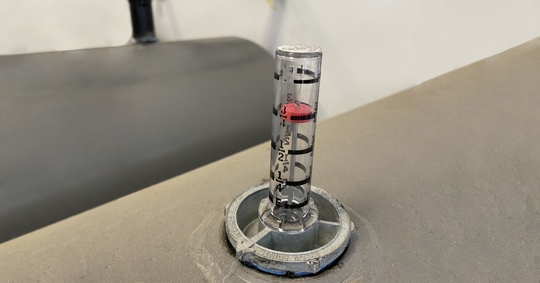How to Read an Oil Tank Gauge
Knowing how to read your oil tank gauge is one of those critical homeowner skills you may not have known you needed. That is, until you find yourself wondering if there’s enough oil in the tank to get you through a long winter’s night. Even if you have automatic delivery service, regularly checking your home’s heating oil level helps you avoid running low.
If you haven’t done it before, relax: you don’t need a master class to develop the skill. Just keep reading.
Oil Tank Gauge Reading 101
Before checking your heating oil level, it’s important to know how the gauge works. Many oil tanks use a float-style gauges.
Most gauges use rigid metal rods that are attached to a float inside the oil tank. When the tank is full, the float rises and pushes up a disk to the top of the gauge. As the oil is used, the float falls accordingly, and the gauge level drops.
It works like the fuel gauge in your car: it measures the level of fuel remaining, but not the number of gallons you have left. These type of tank gauges are not completely accurate, but they give you a very good approximation of how much oil you have left, and monitoring the level in your tank helps you determine when you may need more.
Step 1 – Locate Your Oil Tank
According to the Connecticut Department of Energy and Environmental Protection, 45% of Connecticut households use fuel oil or other petroleum products as the primary energy source for home heating. And that oil needs to be stored somewhere. Residential home heating oil tanks can be found in a home’s basement, above ground near the exterior of the house, or even buried underground. Most small and mid-sized tanks are installed above ground, while the largest size tanks are usually buried underground. In fact, many homeowners are reluctant to purchase a home that has an underground tank on the property. Above ground tanks are easier to maintain, less expensive to clean up if a leak occurs, and easier to replace at the end of their lifespan.
The standard home oil tank is 275 gallons; however, it’s usually filled to about 240 gallons of heating oil while the rest of the space is for air to allow for expansion, preventing overfilling and leaks. Other common tank sizes are 330, 550 and 1000 gallons. The size of your tank depends on the size of the house and the number of HVAC units (furnaces, hot water heaters, etc.) that are powered by oil.
Step 2 – Find the Oil Gauge
For above ground tanks, the gauge should be located on top of your oil tank. Oil tank gauges usually have a red or yellow plastic disk that is covered by a clear, cylindrical, plastic tube. Most gauges have standard markings to indicate the levels: F (for Full), ¾, ½, ¼, E (for Empty).
Step 3 – Read the Oil Tank Float Gauge
The float in the tube will be positioned around one of the markings to show the fuel level in the tank. There is often confusion about whether to read the level at the top of the float or at the bottom. These float gauges are not precise enough to make such a distinction, so just look for where the middle of the disk lines up with a tick mark to determine the level.
Step 4 – Calculate the Gallons in Your Tank
Reading the gauge indicates the fuel level present in your tank, but it doesn’t tell you how many gallons are left. You can estimate how many gallons you have left in the tank with a simple calculation. Knowing the size of your tank and how many gallons it holds at total capacity helps you figure out the number of remaining gallons. For instance, if you have a typical 275-gallon tank, the average fuel capacity is 240 gallons. If the gauge is on 1/4, divide 240 by 0.25 to calculate that you have around 60 gallons left.
Estimating the gallons you have in your tank will help you determine when it’s time to refill. Depending on your usage, having a quarter of a tank left can last you for a few weeks. But don’t allow your tank to fall below that. Weather conditions and other unforeseen factors could delay a delivery and leave your home without heat! As a rule, heating oil delivery providers like Levco use a proprietary system to schedule your automatic delivery when the tank is about 30% full.
How Can I Tell If the Oil Tank Gauge is Working?
If you suspect your oil tank gauge has gone bad, there’s an easy way to check. Carefully take off the outer case of the gauge and gently push down the float and release it. If the float moves back up to its original position, it’s working properly. If the float stays down or doesn’t move to its original position, the gauge may be broken. Call your HVAC technician to have it checked or replaced.
Is a Heating Oil Float Gauge Accurate?
Heating oil tank gauges that use floats are not considered precision equipment. The float can be prone to wear over time or become less buoyant. Therefore, they should only be used as an approximation of how full a tank is.
Levco Delivers
Levco provides safe and timely heating oil deliveries to thousands of homeowners throughout Fairfield and New Haven counties. Our customers trust Levco’s expertise, reliability and unwavering dedication to safety.
We are available 24 hours a day, 7 days a week for all your home or business HVAC service needs. With a full fleet of trucks and technicians located in Trumbull, we are in your neighborhood almost everyday! Get in touch with a member of our team by calling (203) 533-8249 or filling out this form.


